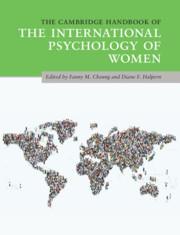Book contents
- The Cambridge Handbook of the International Psychology of Women
- The Cambridge Handbook of the International Psychology of Women
- Copyright page
- Dedication
- Contents
- Figures
- Tables
- Contributors
- Acknowledgments
- Section 1 The Underpinnings of Sex and Gender and How to Study Them
- Section 2 Developmental Perspectives of the International Psychology of Women
- Section 3 Cognitive and Social Factors
- Section 4 Work and Family Issues
- Section 5 Inequality and Social Justice
- 26 Girls, Boys, and Schools
- 27 Understanding Gender Inequality in Poverty and Social Exclusion through a Psychological Lens
- 28 Understanding Women’s Antisocial and Criminal Behavior
- 29 Sexual Assault
- 30 Intercultural Relationships, Migrant Women, and Intersection of Identities
- Section 6 Health and Well-Being
- Epilogue Some Final Thoughts and Take-Home Messages
- Index
- References
28 - Understanding Women’s Antisocial and Criminal Behavior
A Global Review
from Section 5 - Inequality and Social Justice
Published online by Cambridge University Press: 20 July 2020
- The Cambridge Handbook of the International Psychology of Women
- The Cambridge Handbook of the International Psychology of Women
- Copyright page
- Dedication
- Contents
- Figures
- Tables
- Contributors
- Acknowledgments
- Section 1 The Underpinnings of Sex and Gender and How to Study Them
- Section 2 Developmental Perspectives of the International Psychology of Women
- Section 3 Cognitive and Social Factors
- Section 4 Work and Family Issues
- Section 5 Inequality and Social Justice
- 26 Girls, Boys, and Schools
- 27 Understanding Gender Inequality in Poverty and Social Exclusion through a Psychological Lens
- 28 Understanding Women’s Antisocial and Criminal Behavior
- 29 Sexual Assault
- 30 Intercultural Relationships, Migrant Women, and Intersection of Identities
- Section 6 Health and Well-Being
- Epilogue Some Final Thoughts and Take-Home Messages
- Index
- References
Summary
Social scientists have produced numerous studies identifying both gender-neutral and gender-specific causes of crime and delinquency, violence, and other forms of antisocial behaviors. Noting the importance of gender (it is the most robust predictor of offending), this chapter attempts to provide a relatively comprehensive introduction to diverse approaches to understanding female criminality. We review traditional criminological theories and their relevance to understanding crime committed by women and girls, as well as newer perspectives that bring to the fore the lived realities of females, taking into account sexual and other victimization, the gendered nature of violence, and the effects of patriarchal, capitalistic systems. We recognize that all women are not alike and encourage additional theoretical work that specifically considers cultural variations.
Keywords
- Type
- Chapter
- Information
- The Cambridge Handbook of the International Psychology of Women , pp. 402 - 416Publisher: Cambridge University PressPrint publication year: 2020
References
Suggested Readings

Hua (Sara) Zhong is an Associate Professor at the Department of Sociology at the Chinese University of Hong Kong and an Honorary Research Fellow of Hong Kong Police College. She has been a visiting scholar at the Institute of Criminology, Cambridge University and at the Cybercrime Observatory, Australian National University. Her research and teaching interests include criminology, social psychology, and gender studies. Currently she has several ongoing projects on social change and trends of crime/delinquency/substance use by gender and across cultures. Her publications have appeared in Criminology, Journal of Research in Crime and Delinquency, Journal of Criminal Justice, Feminist Criminology, Journal of Youth and Adolescence, and International Journal of Offender Therapy and Comparative Criminology. Zhong grew up and did her undergraduate studies in Mainland China, and received her PhD from Pennsylvania State University. She stayed in Taiwan for several months to study the relationship between modernization and Taiwan’s crime trends by gender and age. One of her research areas is comparative crime and criminal justice. She has established an international research team including scholars from the USA, the UK, Australia, Denmark, Japan, South Korea, India, Ghana, and Greater China. Their main focus is the recent crime trends (by gender, age, and ethnicity) in different societies and how to explain such changes.

Judith Ryder is Professor and Director of the Criminology and Justice master’s program in the Sociology and Anthropology Department, St. John’s University (NYC). She is also affiliated faculty and former Director of the Women’s and Gender Studies program. Her scholarship addresses gender, adolescence, and violence, considered within critical, psychosocial, and feminist theoretical frameworks. A current project examines how globalization affects the escalation of system-involved young women internationally. She has been a Visiting Fellow at the Scottish Centre for Crime and Justice Research, University of Glasgow, and has extensive experience in the not-for-profit sector. Ryder is the author of Girls and violence and her work has appeared in Crime & Delinquency, Critical Criminology, Feminist Criminology, and Women & Criminal Justice.
Ryder grew up in Detroit, Michigan. She took her university studies in Michigan, Santa Barbara, and New York. She presented on Women in the Aftermath of the Arab Spring in Amman, Jordan, and has ongoing research on families and violence in the UK, and on the effects of globalization on the criminalization of young women internationally. In March 2019, she presented at the United Nations’ 63rd Session of the Commission on the Status of Women on educational programming for incarcerated women and girls around the world.



